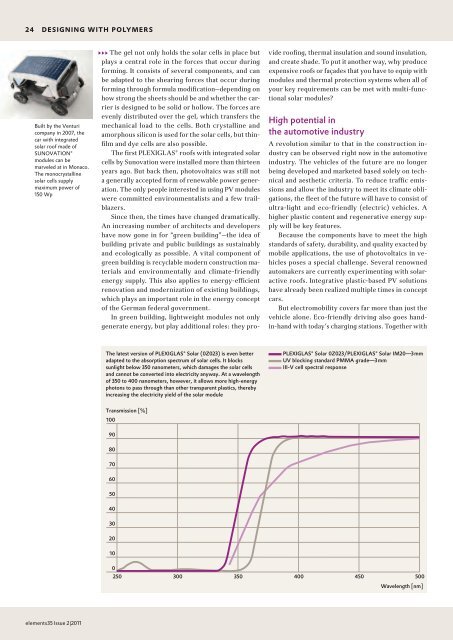Download - Evonik Industries
Download - Evonik Industries
Download - Evonik Industries
Create successful ePaper yourself
Turn your PDF publications into a flip-book with our unique Google optimized e-Paper software.
24 DesIGnInG WItH PoLYMeRs<br />
Built by the Venturi<br />
company in 2007, the<br />
car with integrated<br />
solar roof made of<br />
SUNOVATION®<br />
modules can be<br />
marveled at in Monaco.<br />
The monocrystalline<br />
solar cells supply<br />
maximum power of<br />
150 Wp<br />
elements35 Issue 2|2011<br />
333 The gel not only holds the solar cells in place but<br />
plays a central role in the forces that occur during<br />
forming. It consists of several components, and can<br />
be adapted to the shearing forces that occur during<br />
forming through formula modification—depending on<br />
how strong the sheets should be and whether the carrier<br />
is designed to be solid or hollow. The forces are<br />
evenly distributed over the gel, which transfers the<br />
mechanical load to the cells. Both crystalline and<br />
amorphous silicon is used for the solar cells, but thinfilm<br />
and dye cells are also possible.<br />
The first PLEXIGLAS® roofs with integrated solar<br />
cells by Sunovation were installed more than thirteen<br />
years ago. But back then, photovoltaics was still not<br />
a generally accepted form of renewable power generation.<br />
The only people interested in using PV modules<br />
were committed environmentalists and a few trailblazers.<br />
Since then, the times have changed dramatically.<br />
An increasing number of architects and developers<br />
have now gone in for “green building”—the idea of<br />
building private and public buildings as sustainably<br />
and ecologically as possible. A vital component of<br />
green building is recyclable modern construction materials<br />
and environmentally and climate-friendly<br />
energy supply. This also applies to energy-efficient<br />
renovation and modernization of existing buildings,<br />
which plays an important role in the energy concept<br />
of the German federal government.<br />
In green building, lightweight modules not only<br />
generate energy, but play additional roles: they pro-<br />
The latest version of PLEXIGLAS® Solar (0Z023) is even better<br />
adapted to the absorption spectrum of solar cells. It blocks<br />
sunlight below 350 nanometers, which damages the solar cells<br />
and cannot be converted into electricity anyway. At a wavelength<br />
of 350 to 400 nanometers, however, it allows more high-energy<br />
photons to pass through than other transparent plastics, thereby<br />
increasing the electricity yield of the solar module<br />
Transmission [%]<br />
100<br />
90<br />
80<br />
70<br />
60<br />
50<br />
40<br />
30<br />
20<br />
10<br />
vide roofing, thermal insulation and sound insulation,<br />
and create shade. To put it another way, why produce<br />
expensive roofs or façades that you have to equip with<br />
modules and thermal protection systems when all of<br />
your key requirements can be met with multi-functional<br />
solar modules?<br />
High potential in<br />
the automotive industry<br />
A revolution similar to that in the construction industry<br />
can be observed right now in the automotive<br />
industry. The vehicles of the future are no longer<br />
being developed and marketed based solely on technical<br />
and aesthetic criteria. To reduce traffic emissions<br />
and allow the industry to meet its climate obligations,<br />
the fleet of the future will have to consist of<br />
ultra-light and eco-friendly (electric) vehicles. A<br />
higher plastic content and regenerative energy supply<br />
will be key features.<br />
Because the components have to meet the high<br />
standards of safety, durability, and quality exacted by<br />
mobile applications, the use of photovoltaics in vehicles<br />
poses a special challenge. Several renowned<br />
automakers are currently experimenting with solaractive<br />
roofs. Integrative plastic-based PV solutions<br />
have already been realized multiple times in concept<br />
cars.<br />
But electromobility covers far more than just the<br />
vehicle alone. Eco-friendly driving also goes handin-hand<br />
with today’s charging stations. Together with<br />
PLEXIGLAS® Solar 0Z023/PLEXIGLAS® Solar IM20—3mm<br />
UV blocking standard PMMA grade—3mm<br />
III-V cell spectral response<br />
0<br />
250 300 350 400 450 500<br />
Wavelength [nm]
















